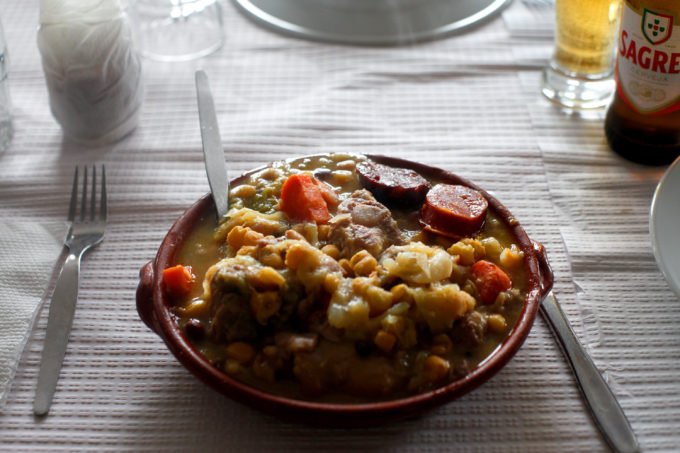
In Lisbon, A Stew for the Homesick Cape Verdean Soul

In Lisbon, A Stew for the Homesick Cape Verdean Soul
Cachupa in Lisbon
Hop on a boat in Dakar, Senegal and head west for 400 miles. There, you’ll find a remarkable volcanic archipelago: Cape Verde. These ten islands endured the first European colony in the tropics and centuries of slave trade and settlement under Portuguese rule. They became independent in 1975. These days, Cape Verde is known for its lush beaches and vibrant music scene.
Whether your day is spent on a beach or at work, you need to eat right, and there is one dish that is Cape Verdean to the bone: cachupa. It’s a stewed mass of hominy, beans, cassava, green banana and, if money allows, meaty bits of the pig (or cow, or fish). That’s cachupa fresca.
The morning after the dinner the night before, the leftovers are dried and fried into heap of chewy succulence, topped with a fried egg and an oily little nugget of linguiça sausage. That’s cachupa refogada, a mighty breakfast that can fuel a body for a whole day.
Breakfast here has to pack a punch. Gorgeous as it is, the landscape doesn’t make for easy living. The arid, volcanic peaks and blankets of sand and salt demand the efficiency of cheap, caloric cachupa. The harsh conditions produced a nation in diaspora. More people of Cape Verdean descent live outside Cape Verde than in it. They may be spread across the globe, but they hold on proudly to their identity, and from Massachusetts to Rotterdam to Lisbon, it’s cachupa that keeps that identity nourished.
After spending some weeks there, I did what so many Cape Verdeans have done, and went to Lisbon. But I missed cachupa. Luckily, there are many options. In the São Bento neighborhood, a former hub of Afro-Portuguese life, there’s Tambarina, where you can fill up on hefty breakfast cachupa and return for dinner and tunes until 2 a.m.
After breakfast at Tambarina, wanting more, I took a train to Cova da Moura. It’s a suburb built by Lusophone African immigrants. Its buzzing streets transport you to Praia, Cape Verde’s capital. Cachupa pervades. A belly full of its cachupa will set you straight until they start serving up luscious grilled salmon and a classic violin dance band from the island of Fogo.
Finally, I went to Lisbon’s corporate center and up to the eighth floor of a drab office building. There is Associaçao Caboverdeana. They promote Cape Verde’s rich arts culture, but the real draw is their dining room, with its excellent views and hearty meals.
At lunch, it’s packed with hungry souls relishing some very porky cachupa fresca and, of course, live music. Emilton, the restaurant manager, defines Caboverdeanidade: “Where the music of Cape Verde goes, so does cachupa.”
Emilton laments that his kids, born in Portugal, can hardly speak Kriolu and, tragically, don’t like cachupa. But when they visit Cape Verde, he says, they see their cousins eating cachupa and then they eat it too. But all they need is to come here. In this dining room above Lisbon, you have it all: the sweet, slow sounds of Cape Verdean morna, sung in Kriolu and paired with a dish born way out in the sea.
Associação Caboverdeana
R. Duque de Palmela 2, 1250
Lisboa, Portugal
1 p.m – 3 p.m., Wed-Fri
Tambarina
R. do Poço dos Negros 94, 1200
Lisboa, Portugal
9 a.m. – 2 a.m.
Restaurante O Coqueiro
R. Reis 3, Amadora, Portugal
10 a.m. – 11 p.m., Wed-Mon